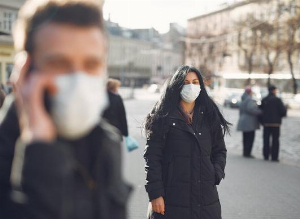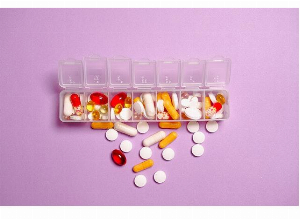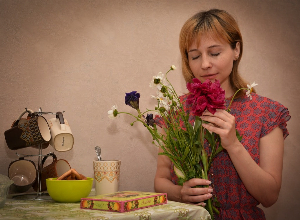End of the COVID-19 Lockdown: How to Carry On with the Coronavirus?
Published May 15, 2020 • By Léa Blaszczynski
After more than a month in lockdown, Americans will have to start to learn to live with the coronavirus. Many in the US are worried about the phased end to the lockdown. No one reacts to the virus in the same way, as the immune system differs according to age, genetic profile and medical history.
What is currently known about the virus? How can we protect ourselves? Are children more at risk? How can we boost our immune system? Let's take a look at the situation!

The virus
What are the possible symptoms?
The list of possible ailments has been growing since March. The most common symptoms are: headache, fever over 100°F, runny nose, cough, sore throat, shortness of breath, chest pain and dizziness. Temporary loss of taste and smell, skin lesions and abdominal pain with diarrhea and nausea has also been observed.
In the most severe cases, the following symptoms have been noted: breathing difficulties, pneumonia and kidney failure. Confusion, encephalitis, stroke and the formation of micro clots have been seen more recently as well.
What should I do in case of symptoms?
You should stay home except to get medical care. Most people with COVID-19 have mild illness and can recover at home without medical care. Make sure to monitor and take care of your symptoms, stay in touch with your doctor, and avoid public transportation, ride-sharing, or taxis if you do go out.
If you experience emergency warning signs (trouble breathing, persistent pain or pressure in the chest, new confusion, inability to wake or stay awake, bluish lips or face) call 911 or call ahead to your local emergency facility. Make sure to let the operator know that you are seeking care for someone who has or may have COVID-19.
If you are sick and are around other people, wear a cloth covering or mask over your nose and mouth. You don't need to wear a mask or cloth covering if you are alone. If you can't put on a mask or face covering (because of breathing problems, etc.), make sure to cover your coughs and sneezes with a tissue or your elbow. Masks should not be place on young children under 2 years of age, anyone who has trouble breathing, or anyone who is not able to remove the mask without help.
The CDC has set up an online tool to help determine if your symptoms are indeed COVID-19 symptoms and to tell you what to do next: CDC COVID-19 Self-Checker
People with COVID-19 who have isolated at home can leave home under the following conditions:
- If you have not had a test to determine if you are still contagious, you can leave home after these three things have happened:
- You have had no fever for at least 72 hours (that is three full days of no fever without the use of medicine that reduces fevers)*
- Other symptoms have improved (ex: when your cough or shortness of breath have improved)
- At least 10 days have passed since your first symptoms appeared
- If you have had a test to determine if you're still contagious, you can leave home after these three things have happened:
- You no longer have a fever (without the use of medicines that reduces fevers)
- Other symptoms have improved (for example, when your cough or shortness of breath have improved)
- You received two negative tests in a row, at least 24 hours apart.
If I have been previously infected with the virus, am I now immune?
At this time, it is not yet known if the antibodies really do protect against the virus. In some individuals, infection with SARS (a close cousin of COVID-19) could, for example, encourage rather than prevent re-infection. Finally, assuming that the antibodies are competent and present in large enough quantities, it is not known how long such protection can last. It is therefore impossible to say that having had COVID-19 prevents re-infection.
Can I boost my immunity naturally?
Yes, through exercise! Physical activity boosts immunity. When we exercise, the immune cells are mobilized, and white blood cells enter the bloodstream to act as "sentinels". So if we exercise every day for 30 minutes (1 hour for children and adolescents), immunity is activated and strengthened. This reduces the risk of developing a comorbidity or susceptibility to infection. To stimulate the good bacteria of the microbiota and boost your immunity, it is also recommended to eat a large quantity of fruits and vegetables!
Going forward
How can we follow the progress of the virus transmission?
Testing for COVID-19 and its antibodies, as well as contact tracing (determining, with the help of people diagnosed with COVID-19, who may have come in contact in order to prevent the spread of the virus), are crucial to finding out how many people have been infected and help to answer crucial questions about the extent and ease of the COVID-19 spread. These tests could give us insight into how many people have been infected and how we should move forward with the phased reopening the nation. It is therefore important to try to get tested if you believe you may have been infected by the coronavirus.
Could summer slow the spread of the virus?
According to Professor Arnaud Fontanet, epidemiologist at the Pasteur Institute and member of the French Scientific Council, in Thailand and Cambodia, which were among the first countries to have had cases after China, there is currently not a crisis like in Europe. Progression of the virus also seems to be equally slow in Africa at present. In the laboratory, the virus is sensitive to heat, just as SARS-CoV-1 was sensitive to heat and humidity. So there may be a seasonal effect, but it may not have an impact until the summer 2021. This is because at the initial onset of a pandemic virus, as was the case in 2009 with Influenza A (H1N1), the virus often remains active during the summer.
Should we fear a second wave?
According to Professor Fontanet, "we have not achieved the level of herd immunity that we would need to avoid a second wave". According to the CDC, as of May 14, just over 10 million tests have been done and around 1,510,924 tests have come back positive. Professor Gypsyamber D'Souza and David Dowdy, professors of epidemiology at the Johns Hopkins University Bloomberg School of Public Health, researchers estimate that only 5% of the Americans are currently immune to the virus, while generally it would take 70-80% to achieve herd immunity. So if we let our guard down, there may be a second wave, as there has been for many major pandemics such as the Spanish flu.
Children
Why do children respond better to the virus than adults?
We initially thought that children were strong transmitters of the virus because we applied the flu model," explains Dr. Marie-Aliette Dommergues, a pediatric infectious diseases specialist at Versailles Hospital. But this is not the case, quite the contrary! There are several hypotheses to explain this. For example, there are fewer receptors for the virus on the surface of a child's respiratory cells. The child's immune system is built up, particularly by having been in contact with other common coronaviruses during the winter, and he or she may have cross-immunity. Finally, there are examples of several infections that are mild in children and become severe in adults, such as influenza, measles or chickenpox. Children are therefore at very low risk of serious complications.
Research
When will there be a vaccine?
There are about 120 research projects underway around the world, notably in the United States (33), China (27) and Canada (11). There are obviously several phases to be respected to develop a vaccine, but "we have never progressed so quickly in just a few months," explains Professor Anne-Geneviève Marcelin, a virologist at the Pitié Salpêtrière Hospital in Paris. A vaccine may be available by 2021.
What is the status of the European Discovery project?
This vast collaborative medical project, launched on 22 March between seven European countries, was designed to test 4 treatments (hydroxychloroquine, remdesivir, lopinavir and ritonavir) on 3,200 patients. Eight weeks after its launch, only France presented 750 patients for clinical trials. However, at least 600 people would be needed for each treatment tested. "If Europeans had worked as quickly as expected, we would have had results," says Professor France Mentré, epidemiologist and head of methodology at Discovery. She notes a lack of "coordination" and a counterproductive proliferation of trials around the world. This is the case of Italy and Spain, which preferred to participate in the Solidarity trial conducted by the WHO. There are no results for the time being, but we already know this from other published clinical trials around the world that involve the same molecules: there is no miracle cure. An independent data assessment committee is due to review the data again on June 3.
Was this article helpful to you? Do you have any thoughts to share with the community?
Take care and stay home!
1 comment
You will also like

What are the dangers associated with the over-the-counter sale of certain medicines?
Dec 19, 2020 • 6 comments

 Facebook
Facebook Twitter
Twitter


